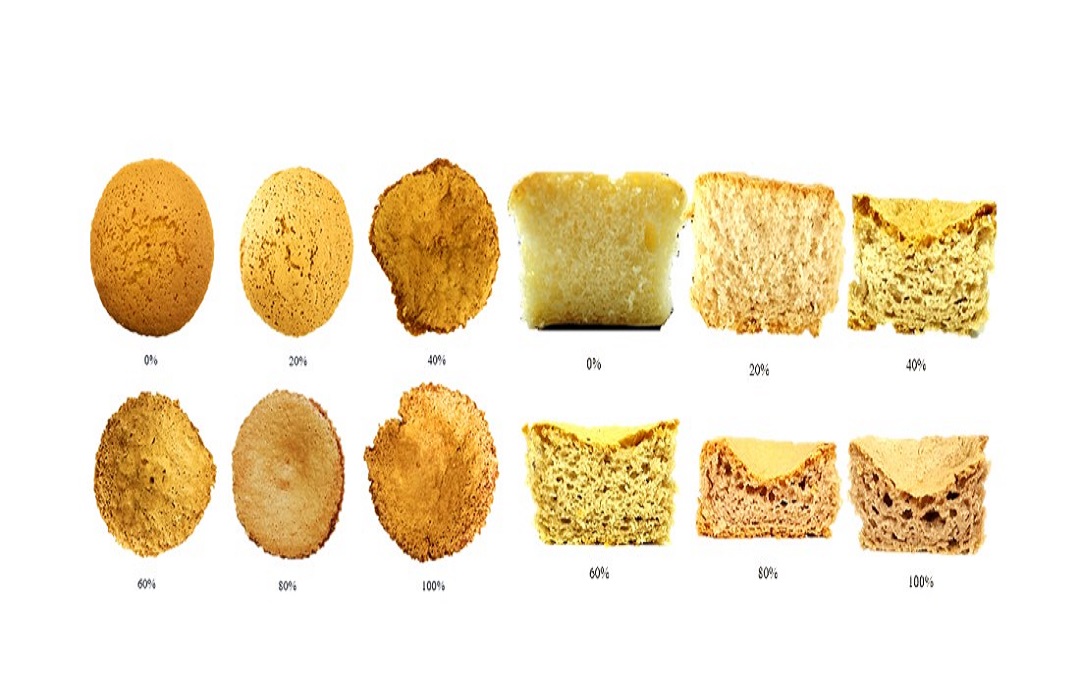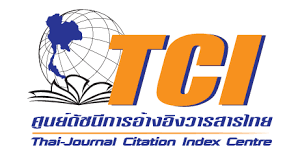The Effects of Using Pregelatinized Red Jasmine Rice Flour as a Substitute for Wheat Flour on the Quality of Sponge Cupcakes
Article 3372
DOI:
https://doi.org/10.69650/ahstr.2025.3372Keywords:
pregelatinized flour, red jasmine rice, substitution, sponge cupcake, antioxidant activityAbstract
This study was an investigation of the effects on the physical and chemical properties, bioactive compounds, and nutritional value of sponge cupcakes when wheat flour was substituted by pregelatinized red jasmine rice flour, at various percentages of substitution. The results showed that the 20% substitution maintained a similar appearance and texture to the control (0% substitution), while the lightness (L*) of both the crust and crumb decreased. Notably, the redness (a*) of the crumb significantly increased (p≤0.05) with higher substitution levels, resulting in a darker color in all substituted samples than in the control. The total color difference (ΔE) also increased, indicating noticeable visual changes. As substitution levels increased, the specific volume significantly decreased from 6.49 mL/g in the control to 3.63 mL/g at 100% substitution. Additionally, hardness decreased from 1070.3 g-forces in the control to 862.5 g-forces at 20% substitution, resulting in a softer texture. The antioxidant capacity improved significantly, with DPPH scavenging activity increasing from 35.26% in the control to 36.30–67.99% at higher substitution levels. This enhancement correlated with the anthocyanin content, which ranged from 1.53 to 2.86 mg/kg in cakes made with red jasmine rice flour. Nutritional analysis indicated that the 20% substitution provided 342.77 kcal, 8.36 g of protein, 14.57 g of fat, 44.55 g of carbohydrates, and 1.21 g of crude fiber per 100 g. These findings suggest that pregelatinized red jasmine rice flour can be used to develop a healthier option for health-conscious consumers and has the potential for development as a gluten-free bakery product in the future.
References
AACC. (2000). Approved methods of the American Association of Cereal Chemists (10th ed.). St. Paul.
AOAC. (2019). Official methods of analysis (21st ed.). The Association of Official Analytical Chemists.
Aulia, L.P., Muchlisiyah, J., Andini, R., & Murtini, E.S. (2016). Physical, chemical, and organoleptic characteristics of chiffon cake with pregelatinized candi banana flour substitution (Musa paradisiaca L.). Food Research, 8(4), 327-335.
Ayutthaya, K., Phota, K., & Nanta, N. (2018). Effect of wheat flour substitution with brown rice flour on sponge cake’s qualities. Journal of Food Health and Bioenvironmental Science (September- December), 11(3), 6-11.
Carillo-Navas, H., Guadarrama-Lezama, A.Y., Vernon- Carter, E.J., Garcia-Diaz, S., Reyes, I, & Alvarez- Ramirez, J. (2016). Effect of Gelatinized Flour Fraction on Thermal and Rheological Properties of Wheat-Based Dough and Bread Journal of Food Science Technology, 53(11), 3996-4006. https://doi.org/10.1007/s13197-016-2399-1
Chamnansilp, P., & Aromrit, A. (2011, February 12-13). Changes of degree of gelatinization, gamma-oryzanol content and antioxidant activity of coloured rice after heating: Proceedings of the 12th Khon Kaen University Graduate Research Conference (pp. 750-756). Khon Kaen.
Chantaraponpan, A., Sakunwiwat, W., & Meekeaw, M. (2019). Physical and chemical properties of Hom Mali Deang brown rice at three stages of grain development. Khon Kaen Agriculture Journal, 47(Suppl.1), 671–678.
Fuengkajornfung, S. (2023). Effect of various colored rice flours on the quality of cricket protein powder fortified chiffon cake. Christian University Journal, 29(1), 68-79.
Gladys, C. C. T, Rocío, M. P. Y, & Angélica, S. L. N. (2021). Quality evaluation through sensory and image analysis of sponge cake crumb with three thermal egg pre-treatments. International Journal of Gastronomy and Food Science, 25, 100390. https://doi.org/10.1016/j.ijgfs.2021.100390
Godefroidt, T., Ooms, N., Pareyt, B., Brijs, K., & Delcour, J. A. (2019). Ingredient functionality during foam-type cake making: A review. Comprehensive Reviews in Food Science and Food Safety, 18, 1550–1562.
Gomez, M., Ronda, F., Caballero, P. A., Blanco, C., & Rosell, C. M. (2007). Functionality of different hydrocolloids on the quality and shelf-life of yellow layer cakes. Food Hydrocolloids, 21, 167-173.
Harakotr, B., Suriharn, B., Tangwongchai, R., & Lertrat, K. (2014). Effects of harvesting times and cooking methods on anthocyanin content and antioxidant activity in purple waxy corn hybrids. Khon Kaen Agriculture journal, 42(3), 337-346.
Hesso, N., Loisel, C., Chevallier, S., Marti, A., Le-Bail, P., Le-Bail, A., & Seetharaman, K. (2015). The role of ingredients on thermal and rheological properties of cake batters and the impact on microcake texture. LWT-Food Science and Technology, 63(2), 1171–1178.
Hongpan N., Ngensombat, K., & Rattanaphiboon, I. (2019). Development of Kanom Ar-lua products from Riceberry flour. Burapha Science Journal, 24(2), 782-794.
Kim, J. M., & Shin, M. (2014). Effect of particle size distributions of rice flour on the quality of gluten-free rice cupcakes, LWT-Food Science and Technology, 59, 526–532.
Liu, R., Sun, W., Zhang, Y., Huang, Z., Hu, H., Zhao, M., & Li, W. (2019). Development of a novel model dough based on mechanically activated cassava starch and gluten protein: Application in Bread. Food Chemistry, 300, 125196. https://doi.org/10.1016/j.foodchem.2019.125196
Lueangsakun, N., & Nuankhaekul, S. (2020). Cooking Bible: Bakery (7th ed.). Amarin Cuisine Publishing.
Loypimai, P., Moongngam, A., & Chottanom, P. (2009). Effects of Ohmic heating on lipase activity, bioactive compounds, and antioxidant activity of rice bran. Australian Journal of Basic and Applied Sciences, 3(4), 3642-3652.
Mau, J. L., Lee, C. C., Chen, Y. P., & Lin, S. D. (2017). Physicochemical, antioxidant and sensory characteristics of chiffon cake prepared with black rice as a replacement for wheat flour. LWT-Food Science and Technology, 75, 434-439.
Phuapaiboon, P., Thancharoen, K., Thamaduangsri, S., Boonsrichana, T., Polphim, K., & Tanaiyasi, A. (2022). Effects of substitution of wheat flour with Hom-Nil rice flour on the quality of chiffon cake. Phra Varun Agriculture Journal, 19(2), 128–137. https://doi.org/10.14456/paj.2022.27
Prom-u-thai, C., Jamjod. S., & Rerkasem, B. (2013, March 26-27). Nutritional values of local Thai colored rice: The Seminar of the Upper Northern and Lower Northern Rice Research Centers (pp. 91–100). Bangkok: Rice Research and Development Bureau.
Ronie, M. E., Zainol, M. K., & Mamat, H. (2021). A review of the recent applications of gluten-free flour, functional ingredients, and novel technologies approaches in the development of gluten-free bakery products. Food Research, 5(5), 43-54.
Shih, F., & Daigle, K. (2002). Preparation and characterization of low oil uptake rice cake donuts. Cereal Chemistry, 79(5), 745-748.
Sinthorn, W., Chatuphonprasert, W., & Jarukamjorn, K. (2015, January 28-30). In vitro antioxidant potentials of four Thai colored rice cultivars. In Proceedings of the 1st International Conference on Herbal and Traditional Medicine (HTM 2015) (pp. 133–137). Pullman Khon Kaen Raja Orchid Hotel, Khon Kaen, Thailand.
Šmídová, & Rysová. (2022). Gluten-Free Bread and Bakery Products Technology. Foods, 11(3), 480. https://doi.org/10.3390/foods11030480
Thanasukarn, P., Petlomtnog, P., Ratanatriwong, N., Prachaiyo, O., & Ratanatriwong, P. (2021). Effect of storage conditions on the qualities of red jasmine rice. Naresuan University Agricultural Journal, 18(1), 1–12.
Tongtangwong, U., & Suwansichon, S. (2010). Effects of wheat flour substitution with Sinin rice flour on qualities of butter cake: Proceedings of 48th Kasetsart University Annual Conference: Agro-Industry (pp. 195-202). Bangkok: Kasetsart University.
Turabi, E., Sumnu, G., & Sahin, S. (2008). Rheological properties and quality of rice cakes formulated with different gums and an emulsifier blend. Food Hydrocolloids, 22, 305-312.

Downloads
Published
License
Copyright (c) 2025 Asian Health, Science and Technology Reports

This work is licensed under a Creative Commons Attribution-NonCommercial 4.0 International License.












